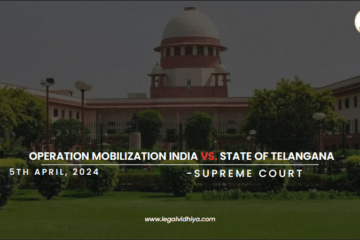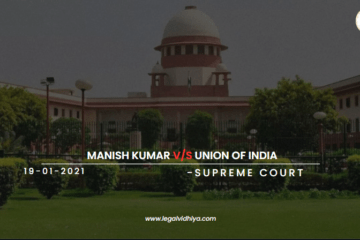
GENERAL INFORMATION
| NAME OF THE CASE | I.C. GOLAKNATH AND ORS. V. STATE OF PUNJAB AND ANR. |
| CITATION | 1967 AIR 1643, 1967 SCR (2) 762 |
| DATE OF THE JUDGEMENT | 27/02/1967 |
| PETITIONER | I.C. GOLAKNATH AND ORS. |
| RESPONDENT | STATE OF PUNJAB AND ANR. |
| BENCH | SUBBA RAO, K.N. WANCHOO, M. HIDAYATULLAH, J.C. SHAH, S.M. SIKRI, R.S. BACHAWAT, V.RAMASWAMI, J.M. SHELAT, VIHISHTHA BHARGAVA, G.K. MITTER & C.A. VAIDIYALINGAM |
| STATUTES/ CONSTITUTION INVOLVED | PUNJAB SECURITY AND LAND TENURES ACT & CONSTITUTION OF INDIA |
| IMPORTANT ARTICLES | ARTICLE 13,19 |
CASE SUMMARY
FACTS OF THE CASE
- In 1953, the Punjab government enacted the Punjab Security of Land Tenures Act, 1953. This Act was placed under the ninth schedule of the Constitution of India by the 17th Constitutional Amendment Act, 1964. Two brothers named Henry and William Golaknath had possession of over 500 acres of land in Jalandhar, Punjab.
- Under the newly enacted Act, the Golaknath brothers were informed by the government that they could only have 30 acres of land and that portion of land would be given to tenants while the rest would be declared surplus and taken over by the government.
- This was challenged by the Golaknath family in court and the matter eventually reached to Supreme Court in 1965. They contested the constitutionality of the Punjab Act, which was placed under the ninth schedule of the constitution of India by the 17th constitution amendment act, 1964 saying it ultra virus.
- The petition was under article 32 challenging the Punjab Security of State Tenures Act, 1953 on the ground that it denies their constitutional rights to hold property and practice any profession [Article 19 (f) and 19 (g)] and to equality before and equal protection of the law (Article 14).
ISSUE RAISED
- Whether the parliament has the absolute power to amend fundamental rights or not?
- Whether the word “law” in Article 13(2) includes amendments?
- Whether the 17th constitutional amendment act is valid in the constitution?
ARGUMENTS FROM THE PETITIONER’S SIDE
- The petitioner’s main argument was about the permanence of the constitution, they were in favour that nobody should have the authority to change or try to bring changes in the constitution.
- They argue that the term “amendment” refers to minor changes only that are in full compliance with the basic structure of the constitution and do not represent an entirely new concept of amendment and article 368 of the constitution clearly describes the procedure of amending the constitution even they argued that parliament has no right to amend the constitution.
- The argument also includes that, According to article 13 – No state or central government can make any law that would deprive the rights mentioned in part 3 of the Indian Constitution through the Constitutional amendment.
- Any amendment in the constitution which violates fundamental rights will be struck down as unlawful and null and void.
ARGUMENTS FROM THE RESPONDENT SIDE
- The state of Punjab answered that the power of amending the constitution is an exercise of sovereign power. The amending power of the Constitution is different from the legislative power of parliament.
- They argued that all provisions of the Constitution has equal status and there is no special status of Fundamental rights in part 3 of the Constitution.
- State of Punjab stated that social needs are changing in society so changes are required in the constitution otherwise the constitution would become too rigid or flexible. The creators of the constitution never wanted our constitution to be inflexible.
RELATED PROVISIONS
Constitution of India
- Article 13(2) – The state shall not make any law which takes away or abridges the rights conferred by this part and any law made in contravention of this clause shall, to the extent of the contravention, be void
- Article 19(f) – Now it has been omitted
- Article 19(g) – Right to freedom to practice any profession, or to carry on any occupation, trade, or business
- Article 368 – article 368 gives the parliament the constituent power to amend any part of the constitution by means of adding new provisions or repealing or modifying existing provisions.
JUDGEMENT
- The Supreme Court had the biggest bench on 27 February, 1967 in the judgement of this case. The petitioner won by a 6:5 margin in the judgement, indicating a majority decision in their favour.
- It was held that the fundamental rights provided under part 3 of the constitution cannot be subjected to process of amendment provided in article 368 if any of such rights provided under part 3 is to be amended, a new constituent assembly must be convened for making a new constitution or radically changing it.
- Justice subba rao, chief justice of India of that time concluded that the 17th amendment violated the fundamental rights of acquiring any land and indulging in any lawful profession granted to the Indian citizens by the constitution.
- The Supreme Court reversed its previous decisions which had upheld parliament’s power to amend all parts of the constitution, including part 3 related to fundamental right. The judgement left parliament with no power to curtail fundamental rights.
CONCLUSION
- The Golaknath v. State of Punjab was one of the important cases in Indian history, which was totally based on basic structure of the constitution. It is considered a landmark judgement regarding Amendability of constitutional rights. The majority said that the fundamental rights are the same as natural rights. These rights are important for growth and development of a human being. The Supreme Court also used Doctrine of Prospective Overruling in the Judgement. This judgement helped to prevent autocracy of parliament. The dictatorship of parliament came to an end by the judgement.




0 Comments